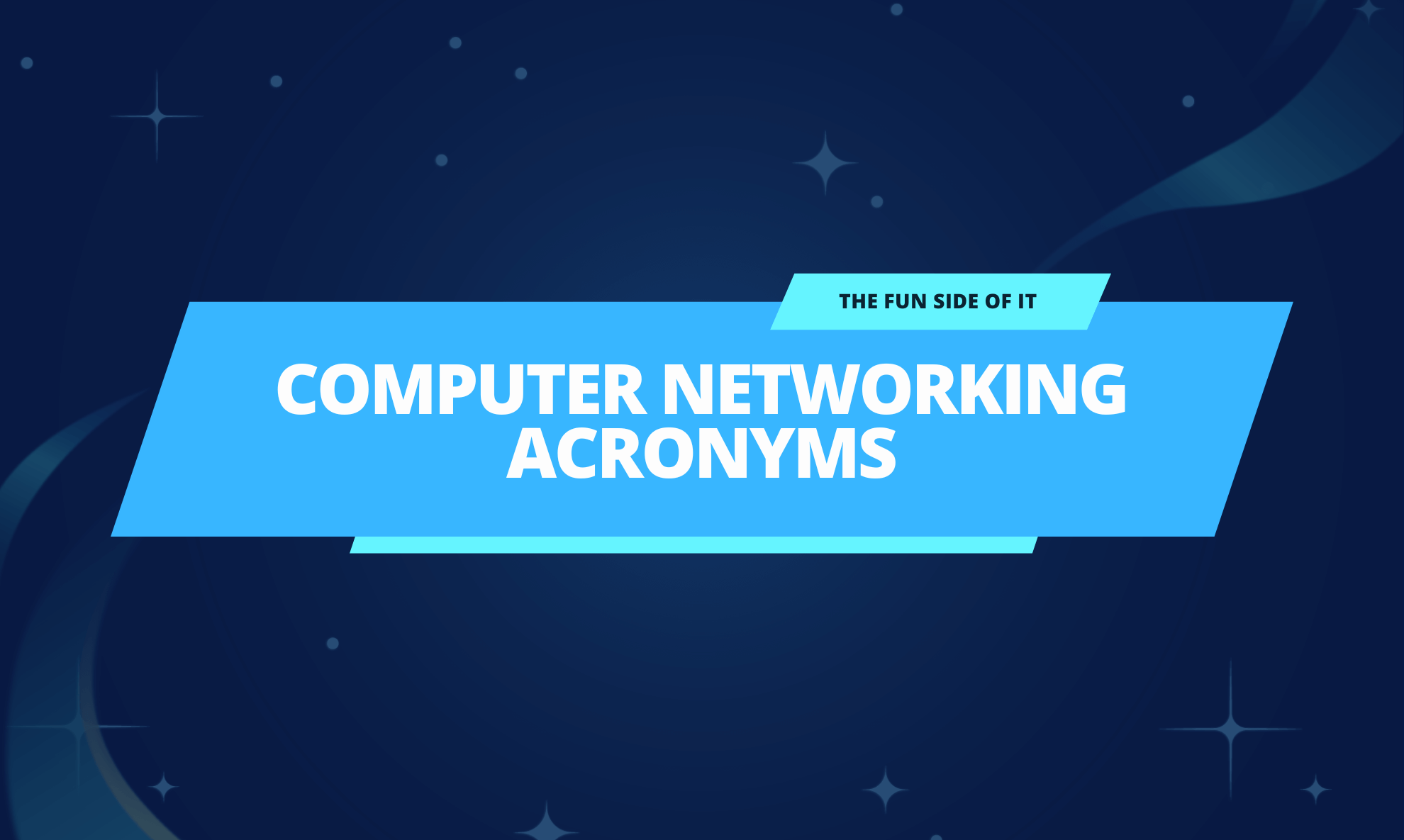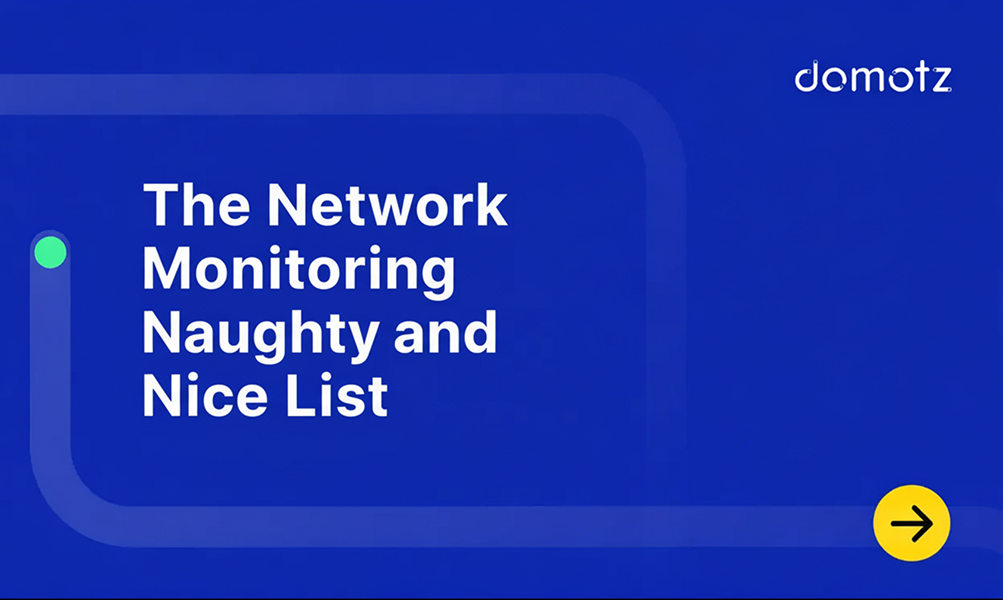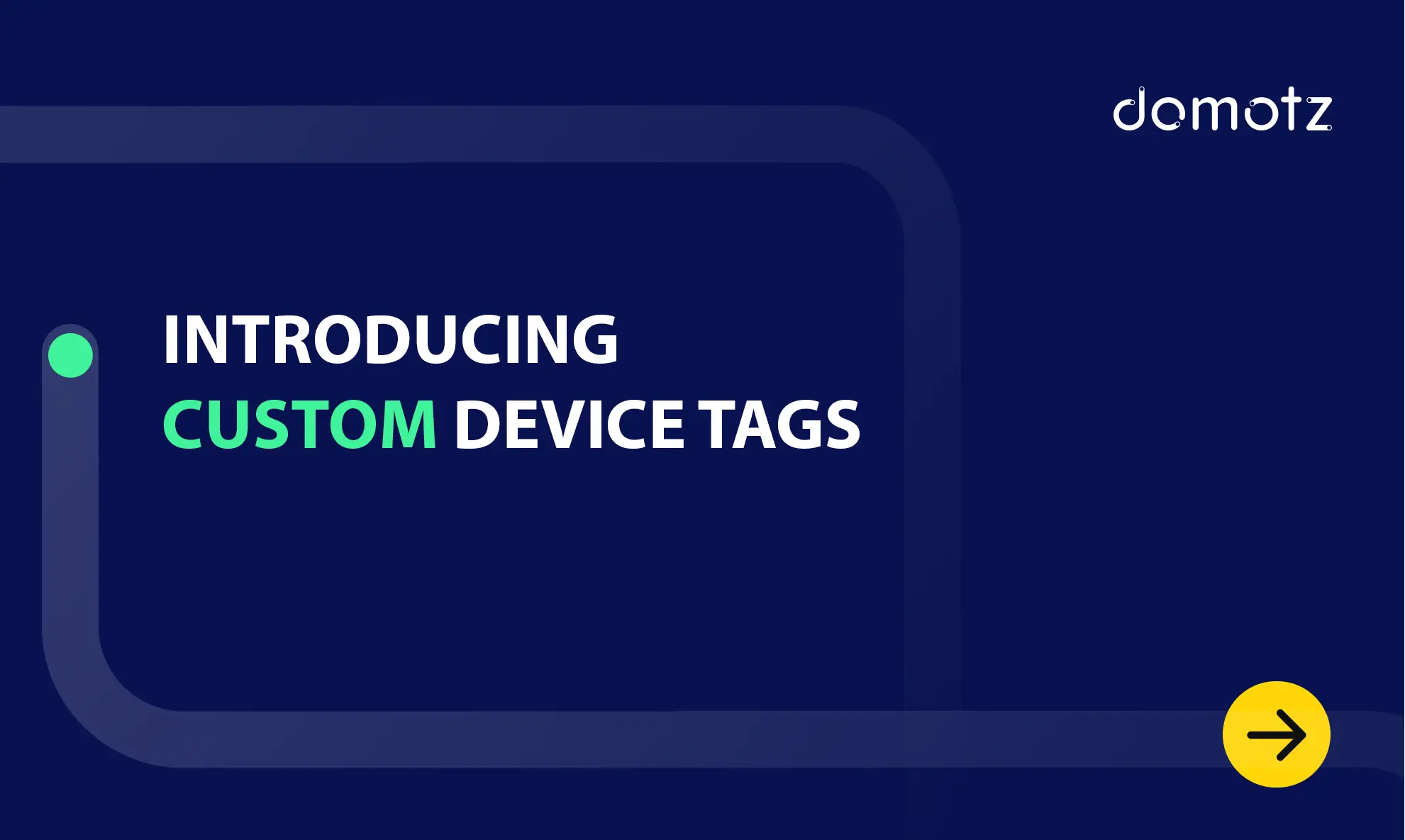25 Computer Networking Acronyms you need to know if you work in the IT space.
Are you using Google to find out common computer network acronyms? Learn what all these confusing initials stand for in our guide.
When someone asks you to do something “ASAP”, you know that it means “As Soon As Possible.”
But, what if your boss asks if you have the “DOM”?
Firstly, he’s not asking for “the DOMcument”.
Moreover, no panic. There is an easy explanation. He wants to know if you have the “Document Object Model” (DOM), a programming API for HTML and XML documents.
There are so many acronyms and abbreviations in the IT space. It’s easy to get lost. Don’t worry our computer networking acronym guide is here to help. We’ve done the heavy lifting and explained all of the most common acronyms used in IT below.
Warm up your fingers and get ready to “ctrl+c and ctrl+v”, take a deep breath and venture into the magical world of computer networking acronyms!
- NMS
- RMM
- PSA
- MSP
- NSS
- WAN
- LAN
- VLAN
- DNS
- VPN
- SNMP
- GCC High
- MTU
- VoIP
- SSH
- OID
- MIB
- CPU
- MAC ADDRESS
- Saas
- SDN
- SSO
- NAS
- RDP
NMS
Network Monitoring Software monitor and manage the network traffic flow over a network. Just in case you missed it, Domotz is a fantastic NMS! You can use this software to monitor both software and hardware components in a network. One of the main benefits of an NMS is that it enables MSPs a central way to monitor and manage their clients’ networks and devices.
Learn all about network management systems and network monitoring best practices.
RMM
Let’s start with a very simple computer networking acronym, RMM, which stands for Remote Monitoring and Management. IT professionals and managed service providers (MSPs) commonly use this software. RMMs are all-in-one solutions for remotely managing computers, networks and related services.
RMMs feature snapshot:
- Above all, it enables control over the network so the operator can manage all desktops, computers, workstations, servers, etc.
- Enables the administrator to install software, and install updates.
- Remote monitoring and alerts for critical events.
- Scripting for processes.
- Automation, patch management, reporting, and more.
An effective RMM lowers your overhead costs, making it possible for you to win more business by providing a more reliable service at a reduced price.
PSA
PSA sometimes means “Public Service Announcement.” But, in the IT world, it stands for Professional Service Automation. This technology allows professional service providers to manage billing, invoicing, project management, contracts, time tracking, and much more.
A PSA should fulfill all team management functions required to run an IT business as an effective support department.
Your daily work will be helped by PSA thanks to a few different management tasks like auditing to demonstrate compliance with data integrity standards, forecasting to determine where extra resources may be required, and many others.
Pro tip: A lot of MSPs like connecting their PSA and NMS tools for maximum efficiency when troubleshooting network and device issues.
MSP
MSP is one of the most important computer networking acronyms in the IT world! It stands for Managed Service Provider. This is a concept whereby a company will outsource certain services to a specialist business.
Typically, MSPs will perform many activities for an organization. These may include:
- providing fully managed hardware outsourcing,
- managing user access accounts on a client’s system,
- offering technical support to staff,
- adding cybersecurity to harden IT systems,
- managing IT infrastructure.
MSPs can provide remote servers or storage and oftentimes are responsible for everything connected to a customer’s network.
They use many tools to perform their job, including PSA tools, RMMs, and NMS software (like Domotz).
Some MSPs simply provide IT expertise to an organization. They prevent those problems and assist users with any usage difficulties.
NSS
NSS stands for Network Security Scans and it identifies a software tool that scans an entire network and its nodes for security vulnerabilities and loopholes.
WAN
When someone tells you some interesting gossip, you may be inclined to shout out:
“What A News!”
Sadly, this isn’t the real meaning of the term WAN. WAN stands for Wide Area Network. This is a big network of information not tied to one location.
LAN
LAN is a little brother of WAN and stands for Local Area Network. This is a collection of devices that are connected together in one physical location, for instance, a home, office, or building.
You’re in luck because our NMS can monitor both your WAN and LAN.
VLAN
Another evolution of LAN is the VLAN or Virtual Local Area Network. It’s a network segmentation that has been partitioned and isolated using Layer 2 of the network. Service providers deal with VLANs all the time when designing networks.
VLANs can keep network applications separate despite being connected to the same physical network, and without requiring multiple sets of cabling and networking devices to be deployed.
A common use case for VLANs is to isolate heavy content traffic networks (such as VoIP, Digital Signage, Unified Communications, security cameras, etc) from the main (and sometimes, higher priority) network.
DNS
Could be the abbreviation of dinosaur or could stand for Domain Name System which is the Internet’s system for converting alphanumeric names (human-readable) into numeric IP Addresses (machine-readable).
Every server connected to the internet has its own public IP address.
When a Web address (URL) is typed into a browser, DNS servers return the public IP address associated with the domain name contained in the URL. Therefore, the computer can connect to the specified server and request the web pages defined in the URL.
VPN
VPN or Virtual Private Network is a way to extend a private network across a public network using an encrypted “tunnel”. A VPN enables you to connect in a secure way from a non-secure public network to a private network, using a secure encrypted “tunnel” that connects your computer to the remote private network.
Access your work data in a secure way with the VPN!
SNMP
Simple Network Management Protocol is a networking protocol used for the management and monitoring of network-connected devices in IP Networks. In other words, SNMP is indeed anything but simple.
It provides a common mechanism for network devices to relay management information within single and multi-vendor LAN or WAN environments. It is commonly used in agentless monitoring because the monitoring solution does not require specific software to be installed on each device.
GCC High
Ok ok, this one is really funny! TCG is a cool mobile app that teaches you how to play Pokémon and become a champion in the community!
Just kidding!
Unfortunately, the computer networking acronym isn’t as fun. GCC in our industry stands for Government Community Cloud.
GCC High meets the requirements of Federal and DoD contractors.
MTU (Maximum Transmission Unit)
MTU is the biggest frame or packet size, which is specified in eight-bit bytes. It can be sent in frame-based or packet-based networks, such as the Internet. Internet’s transmission control protocol (TCP) uses the MTU to decipher the maximum size of every packet within any transmission.
VoIP
No, this isn’t a variation of the commonly used VIP (Very Important Person). VoIP (Voice Over Internet Protocol), also known as Internet calling, Internet telephony, or IP telephony, is an alternative option to a public switched telephone network (PSTN). Definition and use may sound complicated, but they are not.
In conclusion, with VoIP, you can make calls over the Internet, which will save you a lot of money while boosting convenience in the process.
Fun fact: in 1973, Bob McAuley, Ed Hofstetter, and Charlie Radar developed the first voice packet over ARPANET at MIT’s Lincoln Lab.
This voice transmission was possible thanks to LPC, or Linear Predictive Coding — the foundation of modern VoIP technology.
SSH
No, we’re not asking you to shush. SSH stands for Secure Shell Protocol. It’s a cryptographic network protocol. SSH is commonly used to make the operation of network services in a secure manner over an unsecured network. In basic terms, SSH gives computers the ability to communicate and share data. Know more about this topic by clicking here.
OID
OID stands for Object Identifier. This is a long-term and unambiguous name for any sort of entity or object. SNMP enabled networked devices each to have multiple Object Identifiers (OIDs) for various sources of data.
Each OID uniquely identifies a specific “variable” that SNMP can read or set. In some cases (e.g. when part of a structured MIB) the OID can indicate the root node of a tree of variables.
MIB
Nope, it’s not an acronym for a movie we’re talking about.
The MIB we’re talking about stands for Management Information Base which is a database that is utilized for the management of entities within a communication network. The term MIB is usually (but not always) associated with the SNMP or utilized more generically in contexts such as in OSI/ISO network management model.
Searching & Managing MIBs and related OIDs is super fast and easy thanks to our pre-configured SNMP sensors!
CPU
This acronym stands for the Central Processing Unit. It is also known as just a processor, main processor, or central processor. This is the principal part of any digital computer system. An arithmetic-logic unit, control unit, and main memory commonly compose the CPU. The CPU will basically execute instructions that compromise a computer program. It will carry out basic input/output (I/O), controlling, logic, and arithmetic operations, as specified by the instructions in the program.
MAC ADDRESS
No this has nothing to do with Apples.
Someone might ask you for a device’s MAC ADDRESS, and you don’t want to start blushing.
MAC Address or Media Access Control Address is a hardware identification number that uniquely identifies each device in a local area network (LAN, previously explained). The network switches mainly use MACs to build the “forwarding tables”.
These, map MAC addresses to the switch ports and therefore, optimize your LAN performance.
On the other hand, users can mainly assign MAC to device manufacturers and they can also use it to identify the brand and model of each of them.
Saas
Software as a service (Saas) is a software distribution model in which software is made available to customers over the internet. Customers can access the software through a web browser or an application. SaaS is a broad category, and several different types of software can be classified as SaaS.
Want to know more about Saas? We have the perfect article for you.
SDN
We are going to explain this acronym in the easiest way we can. Software-Defined Networks (SDN) is an approach to network management that enables dynamic, programmatically efficient network configuration in order to improve network performance and monitoring. What are the benefits of SDN?
There is a variety of benefits, among others: Network management and visibility, Networking innovations and Simplified policy changes.
DHCP
Dynamic Host Configuration Protocol (DHCP) ) is a network management protocol used to dynamically assign an Internet Protocol (IP) address to any device, or node, on a network so they can communicate using IP. Here are some advantages of DHCP:
- It is easy to implement and automatic assignment of an IP address means an accurate IP address.
- The manual configuration of the IP address is not required.
- Duplicate or invalid IP assignments are not there (no IP address conflict).
SSO
Single sign-on is an authentication scheme that allows a user to log in with a single ID to any of several related, yet independent, software systems. Enable SAML/SSO Authentication on your Domotz account to let you and your team take advantage of your company’s Identity Provider to access Domotz services. Learn how to configure SAML/SSO on Domotz.
NAS
Network-attached storage is a file-level computer data storage server connected to a computer network providing data access to a heterogeneous group of clients.
Learn how to monitor your NAS through the use of Domotz’s monitoring dashboards. Quickly sort, filter and visualize multiple sites and get easy access to the information you need.
RDP
Last but not least, from our computer networking acronyms, Remote Desktop Protocol (RDP) is a proprietary protocol that Microsoft has developed. This will give you access to an application or desktop hosted on a remote host. It enables you to connect, control, and access resources and data on a remote host as if you were doing it locally.
Stay up-to-date on Computer Networking Acronyms
We know you’re probably hungry for more computer networking acronyms now.
Don’t forget to follow us on Instagram.
Do you have any other terms you want to see covered in this list? Don’t hesitate to shoot us a message on Instagram.



